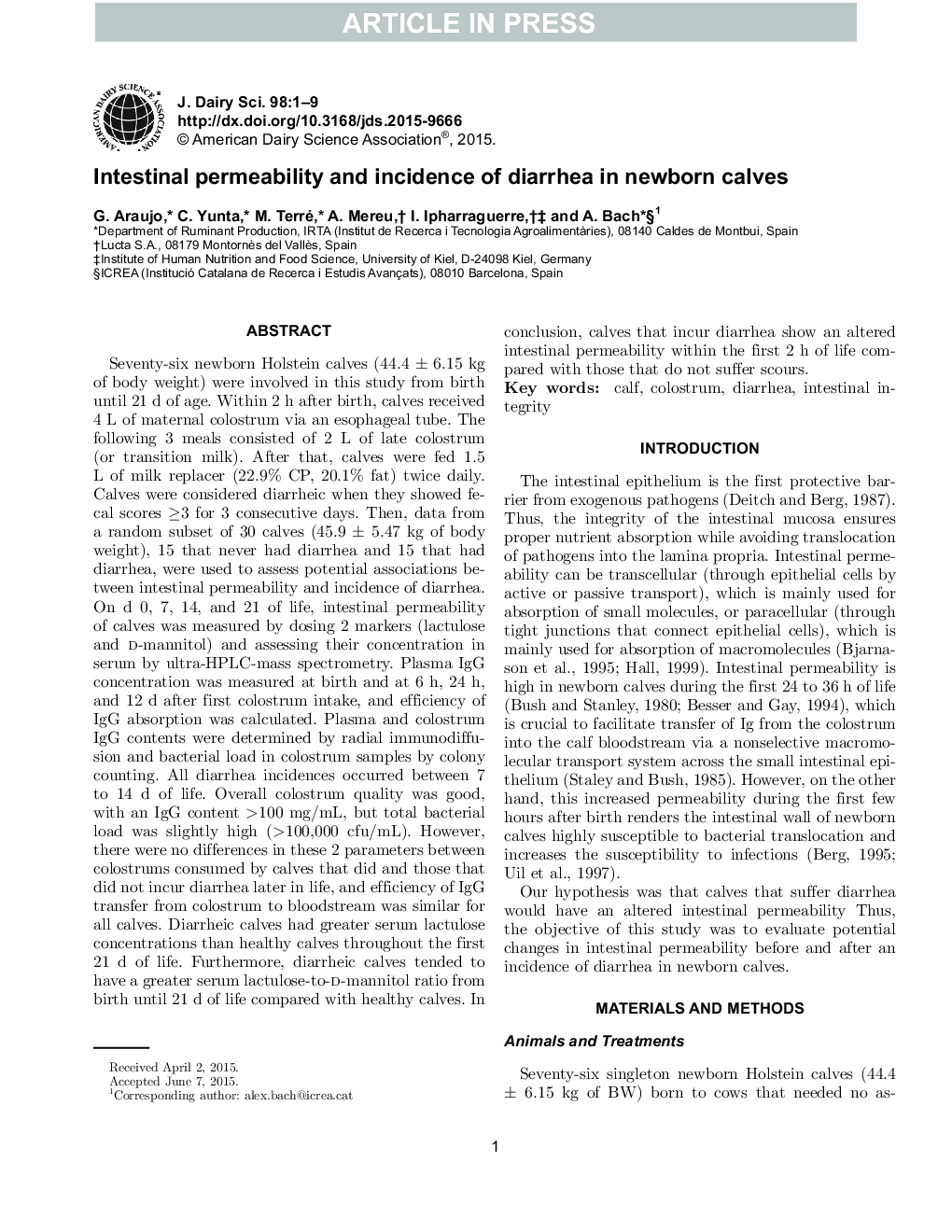| کد مقاله | کد نشریه | سال انتشار | مقاله انگلیسی | نسخه تمام متن |
|---|---|---|---|---|
| 10974956 | 1108029 | 2015 | 9 صفحه PDF | دانلود رایگان |
عنوان انگلیسی مقاله ISI
Intestinal permeability and incidence of diarrhea in newborn calves
ترجمه فارسی عنوان
نفوذ پذیری روده و بروز اسهال در گوساله های تازه متولد شده
دانلود مقاله + سفارش ترجمه
دانلود مقاله ISI انگلیسی
رایگان برای ایرانیان
کلمات کلیدی
گوساله، چای سبز اسهال، یکپارچگی روده،
موضوعات مرتبط
علوم زیستی و بیوفناوری
علوم کشاورزی و بیولوژیک
علوم دامی و جانورشناسی
چکیده انگلیسی
Seventy-six newborn Holstein calves (44.4 ± 6.15 kg of body weight) were involved in this study from birth until 21 d of age. Within 2 h after birth, calves received 4 L of maternal colostrum via an esophageal tube. The following 3 meals consisted of 2 L of late colostrum (or transition milk). After that, calves were fed 1.5 L of milk replacer (22.9% CP, 20.1% fat) twice daily. Calves were considered diarrheic when they showed fecal scores â¥3 for 3 consecutive days. Then, data from a random subset of 30 calves (45.9 ± 5.47 kg of body weight), 15 that never had diarrhea and 15 that had diarrhea, were used to assess potential associations between intestinal permeability and incidence of diarrhea. On d 0, 7, 14, and 21 of life, intestinal permeability of calves was measured by dosing 2 markers (lactulose and d-mannitol) and assessing their concentration in serum by ultra-HPLC-mass spectrometry. Plasma IgG concentration was measured at birth and at 6 h, 24 h, and 12 d after first colostrum intake, and efficiency of IgG absorption was calculated. Plasma and colostrum IgG contents were determined by radial immunodiffusion and bacterial load in colostrum samples by colony counting. All diarrhea incidences occurred between 7 to 14 d of life. Overall colostrum quality was good, with an IgG content >100 mg/mL, but total bacterial load was slightly high (>100,000 cfu/mL). However, there were no differences in these 2 parameters between colostrums consumed by calves that did and those that did not incur diarrhea later in life, and efficiency of IgG transfer from colostrum to bloodstream was similar for all calves. Diarrheic calves had greater serum lactulose concentrations than healthy calves throughout the first 21 d of life. Furthermore, diarrheic calves tended to have a greater serum lactulose-to-d-mannitol ratio from birth until 21 d of life compared with healthy calves. In conclusion, calves that incur diarrhea show an altered intestinal permeability within the first 2 h of life compared with those that do not suffer scours.
ناشر
Database: Elsevier - ScienceDirect (ساینس دایرکت)
Journal: Journal of Dairy Science - Volume 98, Issue 10, October 2015, Pages 7309-7317
Journal: Journal of Dairy Science - Volume 98, Issue 10, October 2015, Pages 7309-7317
نویسندگان
G. Araujo, C. Yunta, M. Terré, A. Mereu, I. Ipharraguerre, A. Bach,
